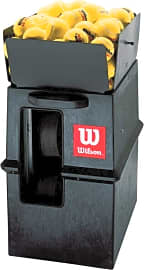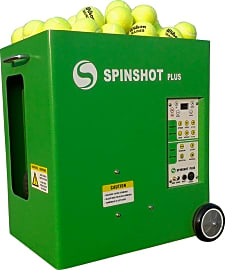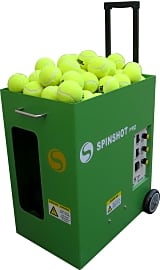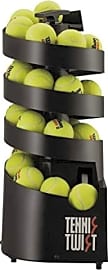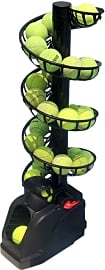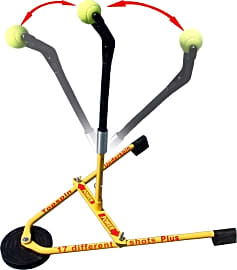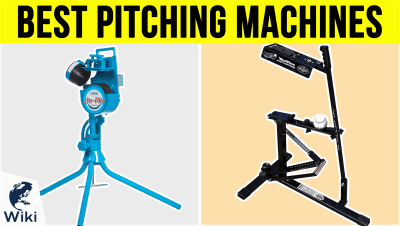The 10 Best Tennis Ball Machines

This wiki has been updated 36 times since it was first published in October of 2016. Taking lessons from a coach can help you attain the proper playing technique, but if you want to get good at any sport, you need to practice, practice, practice. These tennis ball machines allow you to drill those strokes for hours at a time, even if you can't get a partner or a training slot at your club, so you'll be prepared for any real match, when the opportunity comes your way. When users buy our independently chosen editorial selections, we may earn commissions to help fund the Wiki.
Editor's Notes
March 29, 2021:
It wound up being a very busy round of updates. Previously, these rankings comprised a mix of options split between two major players in this space: Spinshot and Lobster Sports. So, when all of Lobster Sports' choices suddenly became unavailable, it left a bit of a gaping hole in our list. It isn’t clear to us exactly what’s going on with Lobster Sports – nothing’s amiss on their website, so it isn’t impossible that they’re just suffering from some sort of severe supply shortage – but we had no trouble finding a whole bunch of great alternatives to include with these rankings, which ultimately saw our list nearly double in length. The options we eliminated, all from Lobster Sports, were the Elite 2, Elite Grand 4 and Elite Grand 5 LE.
Most of our new options come from Sports Tutor, which is a California-based company that specializes in this sort of equipment. From the Sports Tutor Twist – a 28-ball, low-speed, battery-powered machine that’s aimed at amateur athletes – to the Sports Tutor Tower – a 225-ball, high-speed, plug-and-play model that’s built for professionals – the prices these units are offered at varies drastically, but so does the utility they offer. The Tower, for example, costs close to 10 times as much as the Twist, but the quality and intensity of training offered by the former absolutely blow the latter out of the water. The Tower’s top model – the Player version, which is the one we ranked – can even randomize its spin, speed and direction, to simulate an actual opponent. If you’re looking for an intermediate model from the company, we also ranked the Sports Tutor Prolite Plus, and the Wilson Portable was also made in collaboration with Sports Tutor.
At the bottom of our list, to benefit users with limited financial resources or space to play, we included the Meidong Rebound Baseboard and Billie Jean King's Eye Coach. Neither of which are truly fit for a spot closer to the top of our list, but both present a budget-friendly alternative that will appeal to some, especially parents looking for a simple way to get their kids interacting with the sport. The ANBT Lightweight is a step up from those two, as it will actually serve balls, but it won’t be able to offer much of a challenge to a seasoned player, and is even less capable than the Sports Tutor Twist.
Tennis Ball Machines can be a lot of fun, but cleaning up all the balls after the fact rarely is, which is where ball hoppers come in.
December 27, 2019:
During this update, we had to remove a few machines that we previously recommended that we no longer feel most consumers will be happy with. These include the Match Mate Rookie, which seemed to deal with ball feed issues, and the the Isam Extend, which can't put any spin on balls and is too bulky and heavy to be easily moved when needed.
Though we did plenty of searching to find good alternatives for the eliminated models, we came to the conclusion that there are only a few reputable tennis ball machine manufacturers. Due to this, our list is entirely comprised of models from what we believe are the two best companies. That being said, we did include a few other machines in our special honors section.
If you want to feel like you are playing against a live opponent, the Spinshot Plus-2 and Lobster Sports Elite Grand Five LE are the two best options. Not only do they come with a large variety of pre-loaded drills, they allow you to program your own to work on specific skill sets.
On the opposite end of the spectrum, we have the Spinshot Pro, which offers more predictability in shot placement, making it ideal for beginners. It is also significantly more affordable than all the other options on our list, though no one would call it cheap, and very easy to use. The downside is that it offers less versatility in drills.
Whichever model you choose on this list, you are getting to need plenty of balls to fill its hopper. Luckily, we have you covered in that department, too, with a list of the best bulk tennis balls.
Special Honors
Silent Partner Scoop Series Smart Available as either a battery-powered or plug-and-play unit, the Scoop Series Smart features large rear wheels for easy transport. A 22-button remote allows you to control all of the machine's functions from the opposite side of the court, and it beeps loudly every time it registers a command, so you are never left guessing if it has made your desired adjustment. sptennis.com
Sports Tutor Tennis Cube Ideal for causal players, the Tennis Cube is one of the lightest and most compact machines on the market, and one of the most affordable models that operates reliably. It offers a 50-MPH ball speed, a two- to 10-second feed rate, and a start-up delay feature. Just note that the elevation must be adjusted manually. sportstutor.com
Practice Makes Perfect
Dedicated to providing the repetition of constant, high-action ball propulsion, this accessory will simulate the rigors of an actual tennis match.
When it comes to building skill on the tennis court and maintaining your "A game" at all times, having a partner on the other side of the net that never tires of sending a return shot is an invaluable resource. Whether you're just learning the strokes, perfecting that backhand slice, or striving to become the next Serena Williams, you'll need to maintain consistency, accuracy, and power when striking the ball. We're not telling you to abandon the knowledge and wisdom that is delivered from personal coaching, but for those times when you don't have a teacher there to instruct you in technique, what better way to practice on your own than with a tennis ball machine? Dedicated to providing the repetition of constant, high-action ball propulsion, this accessory will simulate the rigors of an actual tennis match.
Tennis ball machines typically come in two main categories: spinning wheel and pneumatic pressure. Resembling an old-style leaf or snow blower, the pneumatic pressure machine consists of an engine with a long tube attached to the end. Typically requiring a lot of power and using an electric motor, the pneumatic machine supplies air pressure to the ball, lodging it within the throat of the tube while a collar holds the ball in place. When enough air pressure has built up inside the machine, the ball is propelled out of the tube and onto the tennis court at high speeds.
Also referred to as counter rotating wheels, the spinning wheel machine is a much more popular design and functions in a similar fashion to the way a pitching machine works. When turned on, the spinning wheel machine first uses an electric fan to draw in outside air for storage in a sealed compartment (or chamber). The air passes through a series of filters on its way into the machine. These filters consist of foam or a screen barrier of some type. Air pressure also builds up inside the chamber. While this occurs, a tennis ball drops from the machine's storage hopper into the chamber where two counter-rotating spinning wheels work to squeeze the ball, keeping it under intense pressure. The ball is then forced into a soft, rubbery, circular tube called a detent, which leads to a small opening. As the ball is lodged in the detent, an airtight seal is formed at the end of the tube. Simultaneously, a plastic flap falls over the entrance, causing air pressure to reach a peak. This peak in air pressure ultimately overpowers the resistance from the detent, propelling the ball out of the tube and onto the court. Upon release, the space within the machine's chamber is then occupied by another ball. This process continues until the hopper's ball supply has been depleted.
A key difference (and benefit) that sets the spinning wheel design apart from its traditional, pneumatically-operating predecessor is in the ability to adjust the speed of its counter-rotating wheels, which allows a player to practice at their own pace. The ability to adjust wheel speed means that a tennis workout can be tailored to suit an individual player's preferences, depending on the type of shot (or spin) he or she wishes to learn and practice.
Finding The Best Features For Success
Because the simulation of real play is important when building skill and perfecting the various strokes, the machine you choose should be versatile enough to deliver shots that you'd ordinarily experience during an actual tennis match. That said, pay attention to the machine's oscillation features. Horizontal oscillation is the most common, as you'll be dealing with constant side-to-side motion against an opponent.
Most launchers offer a speed range of between 10 and 95 miles per hour with capacities between 50 and 300 tennis balls.
The battery power of the machine is also important, considering that extended repetition of strokes and movements on the court are required to perfect your skill. It is also for this reason that counter-rotating wheel systems are ideal, not only for their range of adjustments but also because they can offer extended battery life without the restriction of an AC power outlet.
Many of our options also connect to a smartphone for convenient program control, which comes in handy when you don't feel like crossing the court to make a change to the unit's delivery style, speed, or if you simply want the freedom to move around and control your workout remotely. Dedicated remote controls are a useful teaching accessory for the machine when a coach is around, as well.
Next, pay attention to the available speed range and hopper capacity. Most launchers offer a speed range of between 10 and 95 miles per hour with capacities between 50 and 300 tennis balls.
A Brief History Of The Tennis Ball Machine
The development of the tennis ball machine is credited to tennis player, business leader, and fashion designer René Lacoste, known in modern times for his iconic crocodile logo found on articles of clothing belonging to his brand. Lacoste patented one of the first hand-cranked tennis ball launchers in the 1920s at the humble of age of 24 in collaboration with the Dunlop sports company. The design of this early machine allowed him to perform multiple stroke repetitions. Lacoste is also credited with the invention of the first tubular steel tennis racket.
The first electric-powered tennis ball machines appeared in the 1950s at many tennis clubs, but were not available to the general public.
The first electric-powered tennis ball machines appeared in the 1950s at many tennis clubs, but were not available to the general public. These machines made use of a high-tension spring to launch a bar with a striking head designed to hit a tennis ball to follow varying trajectories. Their speed could also be adjusted to release more or fewer balls per minute.
In 1968, sales executive Robert H. McClure designed and built a new tennis ball launcher called the Little Prince, a pneumatic machine that became one of the first commercially-available launchers.
Today, counter-rotating wheel systems are the favored option of most tennis players, as many are portable with an ability to run on batteries, which certainly comes in handy on the court where access to power outlets is limited.



